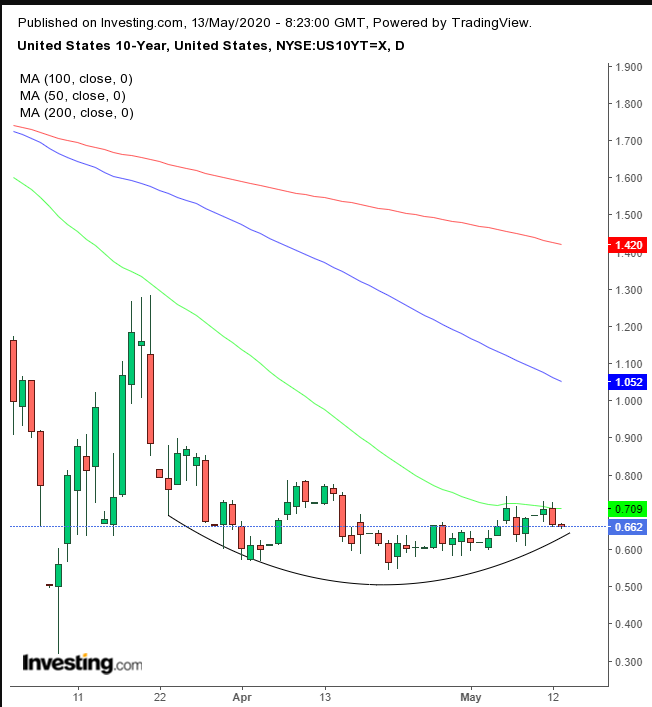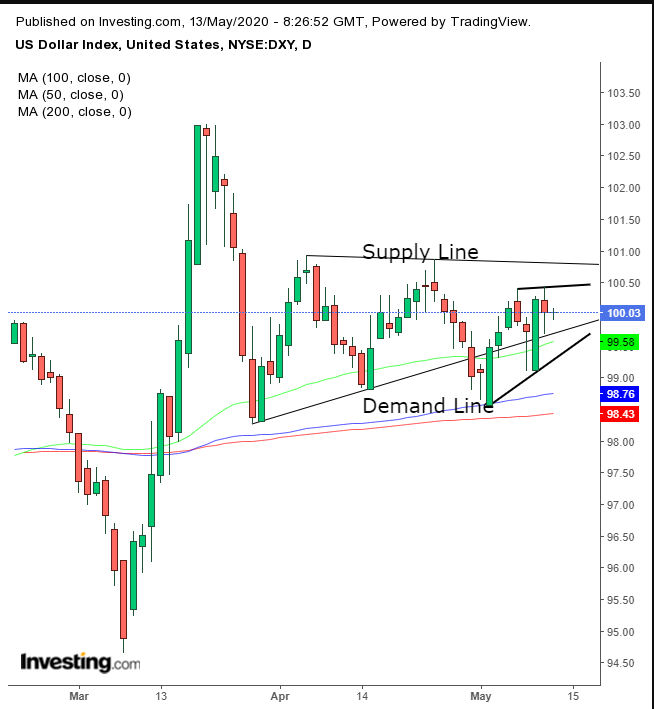- Traders continue to waver between optimism on relaxing lockdown plans and pessimism on warnings of a second wave
- Corporate results continue to reveal deep losses
- Fedspeak considers increasing bank reserves amid potential mass bankruptcies
- OPEC provides its monthly oil market report on Wednesday.
- Fed Chair Jerome Powell speaks on Wednesday.
- U.S. weekly jobless claims data is due Thursday.
- On Friday, China releases industrial production and retail sales data for April.
- The Stoxx Europe 600 Index fell 1.3%.
- Futures on the S&P 500 Index gained 0.1%.
- Germany’s DAX dipped 1.7%.
- India’s Sensex jumped 2%.
- The Dollar Index was little changed.
- The euro held steady at $1.0846.
- The British pound increased 0.2% to $1.228.
- The Japanese yen strengthened 0.1% to 107.07 per dollar.
- The yield on 10-year Treasuries gained less than one basis point to 0.67%.
- Germany’s 10-Yeary yield fell two basis points to -0.52%.
- Britain’s 10-year yield declined two basis points to 0.226%.
- New Zealand’s 10-year yield decreased 12 basis points to 0.626%.
- West Texas Intermediate crude fell 0.5% to $25.65 a barrel.
- Gold was little changed at $1,703.51 an ounce.
Key Events
U.S. futures for the Dow Jones, S&P 500, Nasdaq and Russell 2000 all fluctuated on Wednesday and European stocks dropped, following a Wall Street selloff late in Tuesday's session. U.S. markets turned lower after Dr. Anthony Fauci, one of the country's top health officials, warned during his Senate testimony yesterday that the coronavirus pandemic was not yet contained. As well, he predicted that if the economy reopened too soon, without proper precautions and testing in place, "we run the risk of having a resurgence."
Adding the the dire newsflow, a variety of Fed speakers deflated hopes of a return to the old normal, though the possibility of negative rates has been ruled out...for now.
Rising Treasurys boosted the dollar at the expense of gold.
Global Financial Affairs
U.S. futures wavered between slight gains and losses this morning after Tuesday's selloff during the New York session saw the four major U.S. indices each drop by 2%.
Fed officials speaking at a variety of venues yesterday, didn't hold back. They delivered the cold, hard facts to investors: the lockdown could cause widespread bankruptcies that would leave a lasting impact on U.S. growth. To that effect, the Fed is considering tightening, increasing the amount of reserves banks must hold, to avoid a run on financial institutions—the cause of the 1929 Great Depression.
Today, auto and mining shares dragged the Stoxx Europe 600 Index as corporate results reveal the depth of losses to European business amid the global pandemic.
Denmark-based Maersk (CSE:MAERSKa), the world's largest container shipping company released earnings results this morning, and said it expects volume to plunge by a historic 25%. Dutch lender ABN AMRO Group (AS:ABNd) this morning announced its first loss since 2013.
Stocks in Asia were uneven as investors did their best to wade through the risks. While India’s BSE Sensex 30 surged, +2.3%, on expectations of new government stimulus, Japan’s Nikkei dropped by 0.5%. China’s Shanghai Composite once again managed to cling to the green, +0.2%, despite being in the crosshairs of both medical and financial hazards via another trade war with the U.S.
The yield on the 10-year Treasury fell for a second day.

It was the benchmark note's fourth attempt this week to cross over the 50 DMA. The technical picture is unclear though, as rates appear to be forming a rounding bottom. However, it couldn’t be a bottom after such short, preceding decline in March, not to mention the lower bottom in the same month.
The dollar was flat after yesterday's trading ended with a slight decline.

Like yields, the technical picture for the greenback is unclear. The price has been forming an ascending triangle—innately bullish—but confusing following a drop, which would put the currency's range on track for another leg down, not up.
Also, two downside fakeouts have been developing a rising flag, bearish after the preceding six-day-straight loss. We’re calling a bearish flag on top of a counterintuitive bullish triangle. And before the flag’s formulation, prices went both down and up.
WTI fell.

But the commodity is still within the narrow range for the sixth day, below the neckline of a H&S bottom.
